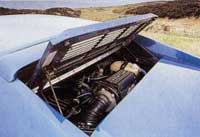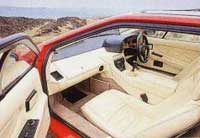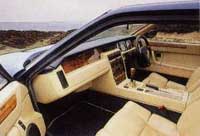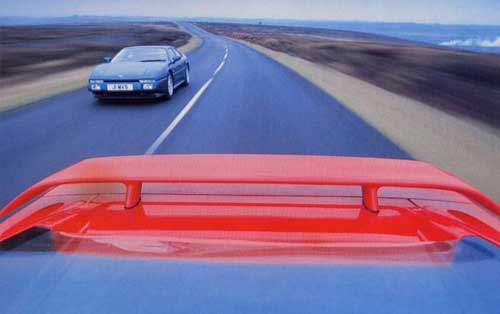

The icon and the upstart
Lotus Esprit and MVS Venturi:
one is a legend, the other a footnote in history.
But which way round should that be?
It only had four cylinders, but it looked as exotic as any V8-powered supercar. It came from Norfolk, rather than Modena. It followed a string of kit cars, not a bloodline of thoroughbreds. But it had Formula One championship heritage and it was styled by Giorgettor Giugiaro. The Lotus Esprit couldn't help but become a part of motoring folklore.
Colin Chapman, Lotus founder and genius of the shoestring racer, moved upmarket in the Seventies. As a concept car, it was the stiletto-nosed sensation of the 1972 Turin Show: all eyes were on Giugiaro's ItalDesign and the future was wedge-shaped. Four years on and barely altered since its stunning debut, the Esprit became reality. The Elan, epitome of the Sixties sports car, had become a memory. Superstardom came in 1977, when the Esprit - modified by Q so it could swim - co-starred with Roger Moore as James Bond in The SPy Who Loved Me.
By 1980, it was time for a bit more power to live up to the looks: hence the Turbo Esprit, with a 210bhp, 2.2-litre turbocharged engine (up from the original 160bhp naturally-aspirated two-litre) and slightly beefier detailing. But it was still recognisably Giugiaro's sharpest shock on wheels. By the mid-Eighties, those purist lines had become a little too classic. Lotus cars had never been cheap - even the Elan cost nearly as much as a Jaguar E-type. Supercar fans wanted swoops, curves and slats. Up against the Ferrari 348tb and the old (but highly evolved) Porsche 911, the Esprit was looking a bit fragile.


Both kick out similar power and thrust you towards
the horizon with blinding effectiveness


Both engines are belters, but the Lotus feels
more like a racing car -
right down to the cramped footwell with barely enough space for Cinderella's
foot around the clutch pedal
Enter Peter Stevens to re-work Giugiaro's original and make it all the fitter to take on the 1987 crowd. That crowd was expanding. Japan invaded supercar territory in 1990 with NS-X. And France had already, with the MVS Venturi. Remember it? There aren't many around; barely 600 built and only a handful in Britain. This 1992 Venturi 260 is the only right-hand drive version on British roads, and photographer Michael Bailie remembered it from his days with Perfomance Car magazine: it was the press demonstrator.
Out on the North yorkshire Moors, it's lined up alongside a 1991 Esprit SE. They look like direct competitors: sleek, plastic-bodied, designed for the final decade of the 20th century. They share a similar philosophy: hand-crafted, mid-engined, two-seat performance cars mixing it with the big boys by relying on ingenuity and exclusivity.
They're plunderers of corporate parts bins. In both cases, the exterior mirrors (like on many low-volume sports cars) come from the Citroën CX. Avid spotters will notice the 'jumping' Mercedes windscreen wiper, early BMW 3 Series tail lamps, Renault 5 doorhandles, Fuego windscreen and door glass, and Peugeot 205 interior handles, stalks and switches on the Venturi. The Esprit comes with Toyota Corolla coupé tail lamps, Land Rover discovery door-handles, Morris Ital column stalks and old, old BMC 'Landcrab' interior door handles.
They even come with the same gearbox: a five-speed transaxle from the Renault 25, also fitted to the Alpine GTA. In the Esprit's case it's strapped to 264bhp worth of turbocharged in-line four - a phenomenal achievment for a 2.2(litre, new in 1989 for the SE. The Venturi has a 260bhp turbocharged 2.8-litre V6, sourced from Renault but tuned to its own requirements.
So we're comparing like with like. Both cost around £50,000 new, both are worth mid-teens now. Both kick out similar power and thrust you towards the horizon with blinding effectiveness. Obviously, with total production today beyond the 10,000 mark, it's easier to track down and maintain an Esprit.

Thing is, MVS didn't have Lotus in its sights. It was after Ferrari. Stylist Gerard Godfroy is the man behind the Venturi. 'In the early Eighties,' he says, 'I was working for coachbuilder Heuliez and had to drive a DIno 246GTS to Paris - a 500-mile trip. It left an impression: the ambience, the acceleration, the noise. I decided I wanted to make my own car.'
Godfroy teamed up with Heuliez production engineer Claude Poiraud, in whose basement he worked seven long days a week for nine months creating a car to display at the Paris Show in September 1984. 'I lost 7kg - it was a big job, but it was so rewarding. The car was well appreciated by the public and the industry and there we found our financial partner, Hervés Boulan.'
The first styling exercise had been based around a VW
Golf GTi engine. Boulan insisted that, to work, the car had to be taken
upmarket.
'That's why it has a powerful engine and is so luxuriously finished -
in production, it was no longer a poor man's Ferrari, but a direct competitor
to Ferrari.'
The company name, MVS, stands for Manufacture de Vehicules Sportifs - which translates as 'handbuilt sports cars'. Production began in Cholet, central France, in 1987. At its core is a sheet-steel tub, with an external skin of composite panels, aerodynamically honed in the St Cyr University wind tunnel by Robert Choulet to a respectable drag factor of 0.31.
Today Peter Stevens is MG Rover's director of design, most recently responsible for the outrageous MG X Power SV sports car. You might have heard of him as the stylist of the McLaren F1. In the Eighties, he didn't have the luxury of Godfroy's clean sheet. Instead, he got the Esprit's original backbone chassis, and its glazing, too.
'The Esprit was one of Giugiaro's best designs, and I'm a fan of his work. I was nervous when my Esprit was unveiled - he saw it and liked it.'

Despite the obvious similarities between the
Venturi and the Lotus, the French car was intended as a Ferrari rival
The car had dated, though. 'It had gone the way of the Countach: fussy, decorated, lost its purity. I wanted to get it back to the purity that I'd enjoyed and restore its aerodynamic efficiency. We got it down to 0.34 Cd.'
The project was completed for £1.1 million (pocket
money in Eighties car design terms), with only six people working on it
and no proper studio. 'We worked in the pattern shop, so we could never
stand more than three feet back from our designs. At the end, we had a
new exterior and modified the way the two body halves were joined so it
looked much neater. I'm used to working with proprietary parts - we had
a Toyota Corolla GT 16v coupé around at the time, so I designed
the rear of the Esprit around its tail lamps.'
All the budget was used. 'I wanted to change the interior as well. Technical
director Mike Kimberley allowed us an extra £11,000, which meant
I could re-design the door panels.'
And those Citroën CX mirrors? 'The manufacturers
offered me the tooling for £50,000 - just look how many cars have
used them since!'
These moorland roads are the perfect environment for the Esprit and Venturi.
Hardly any traffic, a decent surface, challenging twists and swoops and
great visibility so you can use their full width and attack them with
verve.
Both cars are incredibly rewarding here, but it's a surprise to find how different they are in character. from outside, they are sleek and low, similar length (about six inches longer than a Ford Focus) and less than four feet tall - although the Esprit is by a good six by a good six inches the wider.
In the Venturi you sit low down but fairly upright behind a tall dashboard. It's comfortable, conventional, easy-access and tastefully furnished with a warm but businesslike ambience somewhere between that of a Jaguar and an Audi.
The Renault V6 starts with a bit of a clatter and electronically restricts you to 3000rpm until it's fully warmed up....after which it kicks in like an after-burner. Blimey, it's quick. There's a huge pile of torque virtually from idle: the turbo gets on the boil instantly and stays there, forcing you into your seat until around 5800rpm, when it tails off slightly so you shift up a gear and find yourself plonked right back into that jet-like power zone.
There is little of the soundtrack emotion you get with a thoroughbred. In fact, the soundtrack is unique. On-boost you lose the rattly valve-gear noise under the swoosh of the turbocharger - is there a Buck Rogers sound effect tape in here?
Never mind, though. you'll be enjoying yourself too much to worry that it's not a race-honed V8. Steering is superbly sharp, reaction to the wheel instantaneous but not nervous. This is a car you quickly become at one with, learning to trust its no-roll entry into bends so your average speed quickly rises. It's beautifully neutral and feels as if it could handle more than 260bhp. that's partly because it also feels really solid - this is no plastic lash-up on a flimsy platform.
In the best French tradition it rides well, keeping you in perfect touch with the tarmac topography, but shielding you from any surface harshness. The only dynamic downside is the gearshift, which lacks a bit of feel and soul, but it slots from ratio to ratio with plasticky accuracy.
The Lotus, product of Colin Chapman's chassis-design talent, should be even better - shouldn't it? Make no mistake, it is fantastic, but you'll need to be more commited. The difference is clear as you struggle to fold yourself into its semi-reclined driving seat and shove your feet into its cramped footwell, the windscreen header rail just an inch from your eyebrows. Great for Le Mans, less so for public roads. It feels a bit Seventies in here, too. There's a sense of occasion certainly, but in 1991 for your £50,000, you'd have wanted Mike Kimberley to have splashed out a bit more than £11,000 on revamping things inside.

Fire it up and there's an angry four-cylinder bellow. Then you'll struggle with a clutch mechanism that demands you depress the pedal fully yet denies you the space to do so unless you're wearing the slimmest shoes. You'll also fight the gearshift, which has a loser, springier action than the Venturi's even though it's the same box of cogs. The position of the lever, which makes you crank your elbow unnaturally, doesn't help.
Get out on the run and you'll forget all that. you'll soon be flowing like a pro, making the most of its extraordinarily muscular engine. Like the Venturi, you don't rev it hard, just go with the flow and reel in the road. It feels more like a racing car than the Venturi does, which is fantastic when you're in the mood. What it doesn't do is the GT trick of being able to stay focused on driving pleasure without wearing you out.
you get the feeling that the traditional Lotus delicacy has been lost as the Esprit has evolved into a superleague sports car. Wider tyres mean the edge has gone from steering accuracy; it follows every hump and hollow so you need your wits about you when you're tanking on, and some bigger bumps come crashing through the structure with enough resolve to give you a real shake.
It's an involving car, the Esprit, more so than the Venturi - but talent-wise it's not an all-rounder. In the early Nineties, it's competitors could sing as well as dance.
So why did the Venturi disappear? Same old story as so
many struggling independants: it ran out of money. A mid-Nineties restyle
saw Venturi evolve into Atlantique, but MVS is moribund now, although
a Lotus Eslise-style back-to-basics roadster is on the books.
Ah, the Elise, saviour of Lotus. Yet the Esprit still trickles out of
Hethel, V8-powered since 1996, and the company has been able to rely on
consultancy work during lean times. The Esprit has had a long life and,
wonderful though it is in many ways, this was not its best era. Even so,
if you want a stunning-looking, powerful sports car, and you're prepared
for the full-on driving experience that's sometimes a bit too involving,
you can have your cake and eat it with the Lotus.
But it's a shame the MVS company flatered. The Venturi is easy to drive quickly and it's comfortable as well. If it was a cale, it would come with jam and cream. And it would taste even better.Thanks to: Philippe Bachelet and Frederic Berkmillet for the Venturi;Paula Perkins and Mark Williamson for the Esprit; Lotus Specialist Paul Matty Sports Cars, Bromsgrove (tel:01527 835656)
1992 MVS VENTURI 260
Engine 2849cc, V6, ohc, Garret T3 turbocharger, EIA electronic fuel injection
Power and Torque 260bhp @ 5750rpm, 298lb ft @ 1750rpm
Transmission Mid-engine, five-speed manual, rear-wheel drive
Brakes Servo assisted discs all round
Suspension Front: independent, unequal length control arms, coil springs, telescopic dampers, anti-roll bar.
Suspension Rear: independent, upper control arm, lateral and trailing links, coil springs, telescopic dampers, anti-roll bar
Steering Rack and pinion, power-assisted
Weight 2760lb (1252kg)
Performance Top speed; 168mph; 0-60mph: 5.3sec
Cost new £49,897
Value now: £17,0001991 LOTUS ESPRIT SE
Engine 2174cc, in-line four-cylinder, dohc, 16-valve, Garret TB03 turbocharger, AC Delco multipoint fuel injection
Power and torque 264bhp @ 6500rpm, 261lb ft @ 3900rpm
Transmission Mid-engine, five-speed manual, rear-wheel drive
Brakes Servo-assisted discs all round
Suspension Front: independent, double wishbones, coil springs, telescopic dampers, anti-roll bar.
Suspension Rear: independent, upper and lower transverse links, radius arm, coil springs, telescopic dampers
Steering Rack and pinion
Weight 2750lb (1250kg)
Performance Top speed: 159mph; 0-60mph: 4.7sec
Cost new £47,307
Value now £15,000
|
|